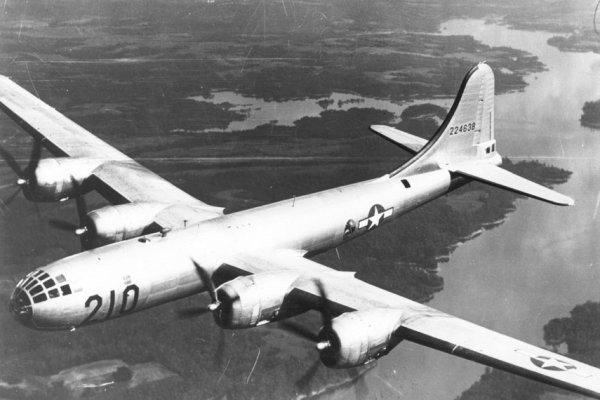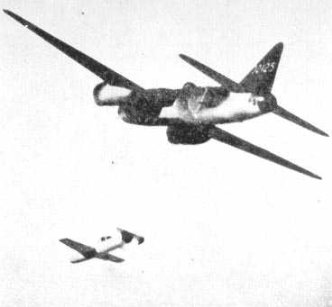ACUFO-1945-00-00-TOKYO-1
In 1999, the collective book “58th Bomb Wing - Wait Till the 58th Gets Here” contained memories of the airmen of this unit in the Pacific Theater of Operations during World War II.
The book quoted from Willis Dean, of the 677th Squadron. Near the end of World War II, at a time when “bombing raids became more frequent and more intense”, and “the Japanese started throwing every conceivable weapon they could find” at the American planes, Willis Dean recalled this incident:
“We were flying from Tinian for a bombing raid on Tokyo. We had finished our run and swung south to head for Okinawa when someone notices a ball of fire on our tail. A 2,000 pound bomb was after us.”
“We had two choices. Go up of go down to try and avoid it. The pilot chose down and we headed towards the water, past red line, then the tail gunner hollered out, 'That ball of fire is following us' The pilot pulled her up, and the ball of fire went blazing into the ocean.”
| Date: | 1945 |
|---|---|
| Time: | ? |
| Duration: | ? |
| First known report date: | 1999 |
| Reporting delay: | 6 decades. |
| Country: | Japan |
|---|---|
| State/Department: | Kanto |
| City or place: | Tokyo |
| Number of alleged witnesses: | 2 or more. |
|---|---|
| Number of known witnesses: | ? |
| Number of named witnesses: | ? |
| Reporting channel: | History book of the unit. |
|---|---|
| Visibility conditions: | Probable night. |
| UFO observed: | Yes. |
| UFO arrival observed: | ? |
| UFO departure observed: | Yes. |
| UFO action: | Followed, crashed and exploded in the ocean. |
| Witnesses action: | Evasive maneuvers. |
| Photographs: | No. |
| Sketch(s) by witness(es): | No. |
| Sketch(es) approved by witness(es): | No. |
| Witness(es) feelings: | ? |
| Witnesses interpretation: | Japanese flying bomb. |
| Sensors: |
[ ] Visual: 2 or more.
[ ] Airborne radar: [ ] Directional ground radar: [ ] Height finder ground radar: [ ] Photo: [ ] Film/video: [ ] EM Effects: [ ] Failures: [ ] Damages: |
|---|---|
| Hynek: | ? |
| Armed / unarmed: | Armed, 12 Browning M2 12,7 mm machine guns. |
| Reliability 1-3: | 2 |
| Strangeness 1-3: | 2 |
| ACUFO: | Possible Japanese plane on fire. |
[Ref. wdn1:] WILLIS DEAN:
A collective book published WWII stories of the 58th Bomb Wing of the U.S. Army Air Forces operations in the Pacific.
The book quotes from Willis Dean, of the 677th Squadron. It happened near the end of WWII, at a time when “bombing raids became more frequent and more intense”, and “the Japanese started throwing every conceivable weapon they could find” at the American planes. Willis Dean recalled this incident:
“We were flying from Tinian for a bombing raid on Tokyo. We had finished our run and swung south to head for Okinawa when someone notices a ball of fire on our tail. A 2,000 pound bomb was after us.”
“We had two choices. Go up of go down to try and avoid it. The pilot chose down and we headed towards the water, past red line, then the tail gunner hollered out, 'That ball of fire is following us' The pilot pulled her up, and the ball of fire went blazing into the ocean.”
The Boeing B-29 “Superfortress” was the heaviest bomber of the U.S. Army Air Forces, used in operations from May 8, 1944 and on. Its maximum speed was 574 km/h.
Its defensive armament was 12 Browning M2 12.7 mm machine guns.

|

|
This story shows how difficult it often is to determine whether this or that “ball of fire” phenomenon reported by B-29 crews in the Pacific were indeed “Japanese weapons”, or if it was a much stranger thing.
The story is too brief, not detailed enough to define with certainty what that “ball of fire” was. That it follows the plane would be normal for an enemy fighter plane, but that it explodes on the water is more reminiscent of some kind of flying bomb.
Aviators had often thought it was the rocket-powered “Baka” piloted suicide flying bomb, which here seems to be a sensible explanation. But there is still this same problem: none of the so-called “Baka” has ever caused the loss of a B-29. The “Baka” was extremely fast, to the point that there is no way it could follow a B-29, that is, fly at the speed of a B-29, without stalling and crashing. The mention that “A 2,000 pound bomb was after us” in the story may indicate that this was Willis Dean's interpretation.
This may seem what happened here. The duration of the pursuit of the B-29 by the “ball of fire” is not given, so this remains a possibility. But at the same time, the airmen should have described the light as rather changing, depending on whether the so-called “Baka” was chasing the B-29 or seen from above when it fell.
It can also be argued that it could have been a conventional Japanese fighter plane in flames. It is somewhat difficult for me to believe that the airmen would not have recognized such an ordinary event, but this would in my opinion be the “least worse” prosaic explanation.
The “Baka”
The «Baka», Japanese designation Yokosuka MXY-7 «Ohka», called “Viper” by U.S. Air Intelligence (Below, dropped by a «Betty»). The first known operational use took place on March 21, 1945, and had no success, the carrier planes having been intercepted by U.S. fighter planes. Historical sources do not mention any attack of the B-29s by the “Baka”.

|
Possible Japanese plane on fire.
* = Source is available to me.
? = Source I am told about but could not get so far. Help needed.
| Main author: | Patrick Gross |
|---|---|
| Contributors: | None |
| Reviewers: | None |
| Editor: | Patrick Gross |
| Version: | Create/changed by: | Date: | Description: |
|---|---|---|---|
| 0.1 | Patrick Gross | June 13, 2024 | Creation, [wdn1]. |
| 1.0 | Patrick Gross | June 13, 2024 | First published. |